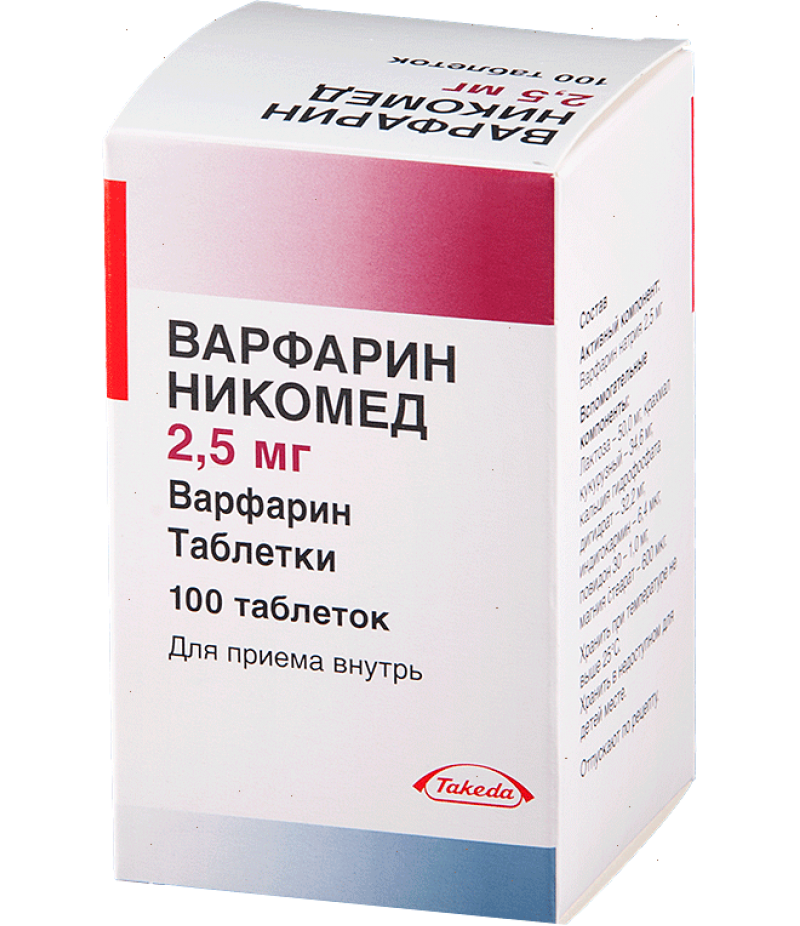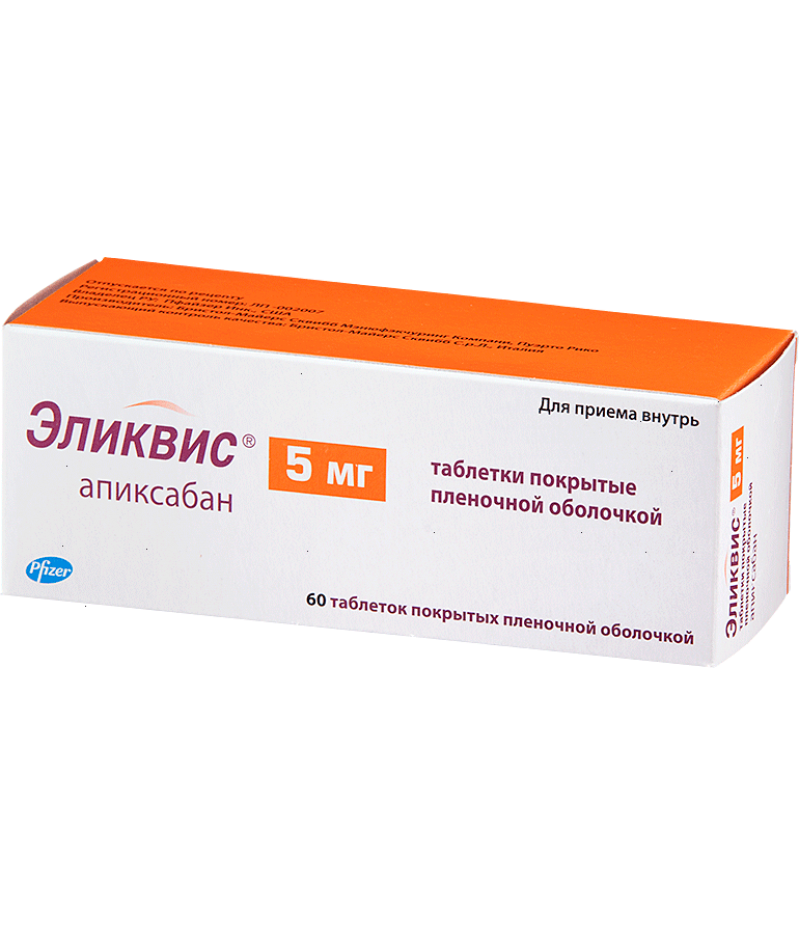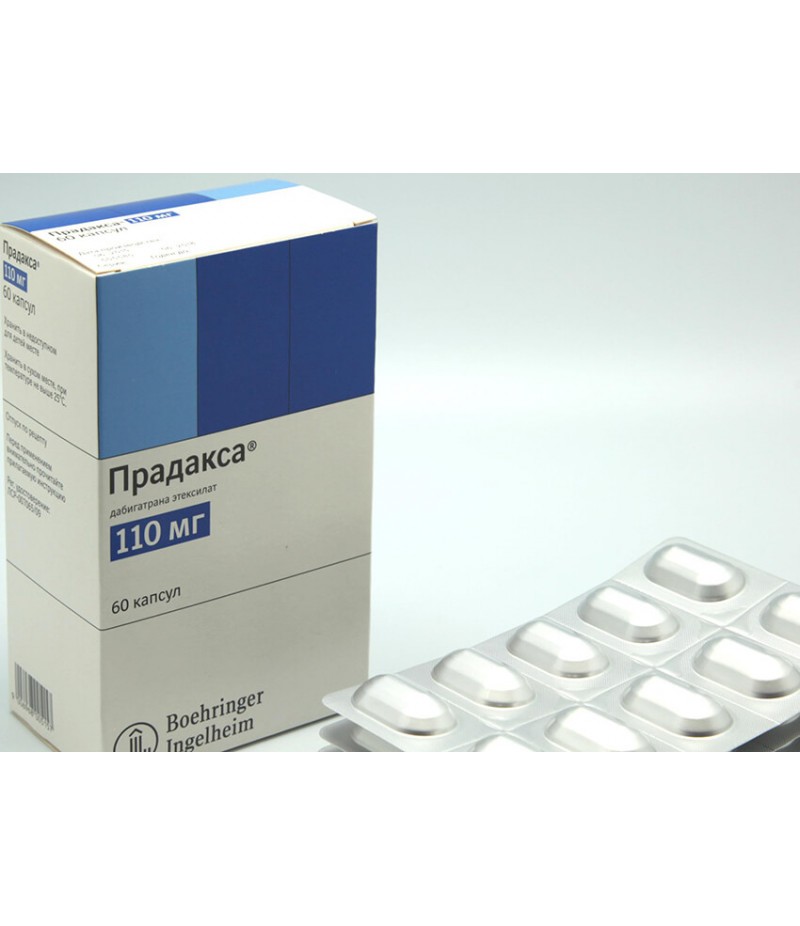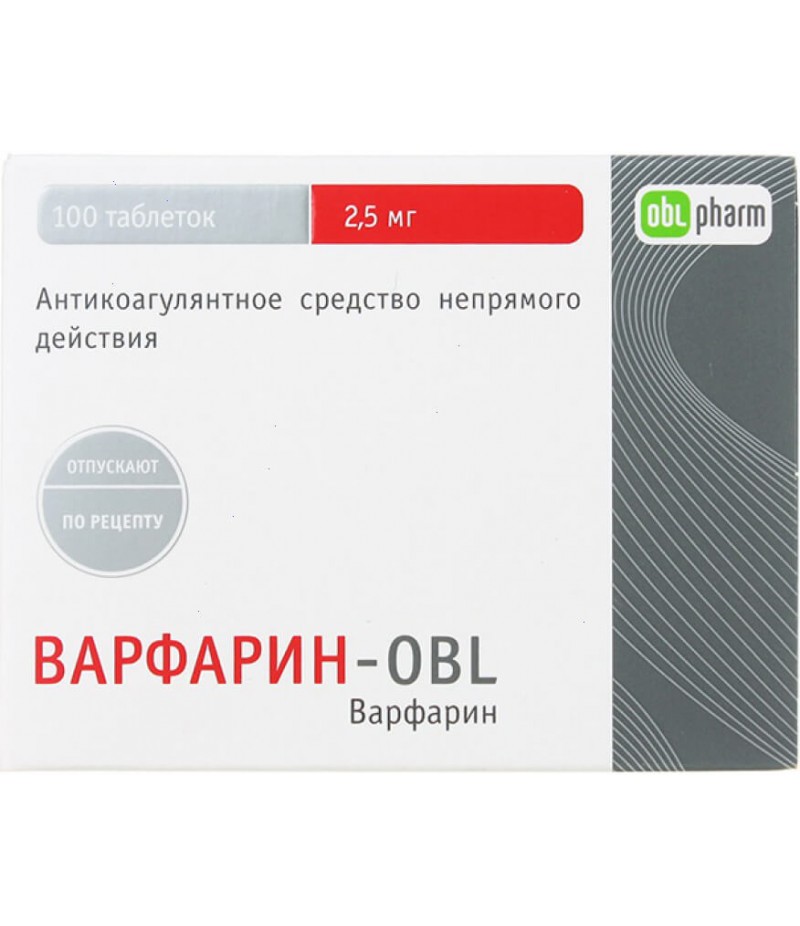Warfarin tabs 2.5mg #100
- $10.99
- 3 or more $10.80
- Availability:In Stock
Warfarin user manualYou can buy Warfarin hereCompositionThe Warfarin Nycomed compound contains the active substance warfarin sodium, as well as additional ingredients: corn starch, lactose, indigocarmine calcium dihydrate hydropho..
Tags: tabs
Warfarin user manual
You can buy Warfarin here
Composition
The Warfarin Nycomed compound contains the active substance warfarin sodium, as well as additional ingredients: corn starch, lactose, indigocarmine calcium dihydrate hydrophosphate, magnesium stearate, povidone 30.
Form of issue
Produced in the form of tablets. Warfarin - a tablet of round shape, light blue, with a cruciform risk. Tablets are packed in plastic bottles of 50 or 100 pieces each. The vials are closed with lids, which are screwed on.
pharmachologic effect
Warfarin in the human body blocks the synthesis of vitamin K-dependent clotting factors in the liver (II, VII, IX, X), it reduces their concentration in the plasma, resulting in a slowdown in the process of blood coagulation.
Pharmacokinetics and pharmacodynamics
After the first administration, the anticoagulant effect is observed after 36-72 hours. The maximum effect is noted in 5-7 days after the start of the course of admission. After the medication has been completed, the activity of vitamin K-dependent clotting factors is restored for 4-5 days.
From the digestive system is absorbed quickly and almost completely. The connection with plasma proteins is 97-99%. Metabolism occurs in the liver.
Warfarin is a racemic mixture, the R and S isomers are metabolized in the liver in different ways. Each isomer is converted into the main two metabolites.
It is excreted in the form of inactive metabolites with bile, metabolites are reabsorbed in the digestive tract, excreted in the urine.
The half-life is from 20 to 60 hours. The half-life of the R-enantiomer is from 37 to 89 hours, the half-life of the S-enantiomer is from 21 to 43 hours.
Indications for use Warfarin
The drug is used to treat and prevent embolism and thrombosis of blood vessels. Such indications for the use of Warfarin are defined:
venous thrombosis in acute form, as well as recurrent;
pulmonary embolism;
strokes, transient ischemic attacks;
prevention of thromboembolic complications in people who underwent myocardial infarction;
secondary prevention of myocardial infarction;
prevention of thromboembolic complications in people with heart valve lesions, atrial fibrillation, as well as in those who underwent prosthetic heart valves;
prevention of postoperative thrombosis.
Contraindications
Before taking medication, you need to take into account those contraindications, which are indicated in the instructions to the drug:
manifestation of high sensitivity to the components of the agent or suspected of increased sensitivity;
acute bleeding;
severe liver and kidney disease;
the first trimester of pregnancy and the last 4 weeks of bearing the fetus;
acute DVS-syndrome;
thrombocytopenia;
deficiency of proteins C and S;
varicose veins of the digestive tract;
aneurysm of arteries;
increased risk of bleeding, including hemorrhagic disorders;
stomach ulcer and duodenal ulcer;
severe wounds, including postoperative wounds;
lumbar puncture;
bacterial endocarditis;
hypertension malignant;
intracranial hemorrhage;
hemorrhagic stroke.
Side Effects of Warfarin
In the course of treatment, such side effects of Warfarin may be manifested:
bleeding - often;
increased sensitivity to warfarin after prolonged treatment;
pain in the abdomen, vomiting, diarrhea, anemia - infrequently;
an increase in the activity of liver enzymes, eosinophilia, urticaria, jaundice, eczema, skin necrosis, itching, rash, nephritis, urolithiasis, vasculitis, tubular necrosis - rarely.
Manifestations of bleeding are noted in about 8% of patients who receive warfarin. Of these cases, 1% are severe, requiring hospitalization, another 0.25% are defined as fatal. The main risk factor for the development of intracranial hemorrhage is uncontrolled or untreated hypertension. Also, the likelihood of treatment with warfarin increases in elderly people, with a history of bleeding from the gastrointestinal tract and strokes, with a high intensity of concomitant anticoagulant and antiplatelet therapy, as well as in people with polymorphism of the CYP2C9 gene.
In rare cases, with the treatment of warfarin, as a side effect, coumarin necrosis may manifest. As a rule, this phenomenon begins with the appearance of swelling and darkening of the skin of the buttocks or legs, less often such signs appear in other places. Later such lesions become necrotic. Approximately in 90% of cases, this side effect develops in women. It is noted from the third to the tenth day of taking the medicine. Its origin is due to the deficiency of the antithrombotic protein C or S. In congenital insufficiency of these proteins, it is necessary to start taking warfarin from small doses and simultaneously administer heparin. With the development of such a complication, stop treatment and inject heparin until the lesions heal.
In very rare cases, the palmar-plantar syndrome may develop. This complication develops in men who suffer from atherosclerosis. This complication is characterized by the development of purple symmetrical skin lesions on the soles of the feet and on the fingers, in which burning pains are noted. Symptoms disappear when the medication stops.
Instructions for use Warfarin (Method and dosage)
The medicine should be taken orally, once a day. It is recommended to drink tablets every day at the same time. Determine how much time to take the drug, should the doctor individually.
Before starting treatment, MHO should be determined, after which laboratory tests are carried out regularly after 4-8 weeks.
The instruction for the use of Warfarin Nycomed prescribes that people who did not take this medicine before, are prescribed 5 mg per knock (2 tablets) for 4 days. On the 5th day, the INR should be determined, after which, according to the results of the study, a maintenance dose is prescribed. As a rule, it is 2.5-7.5 mg of medication per day.
Those patients who have already taken warfarin, for two days, are prescribed a double dose of a known maintenance dose of the drug, then they prescribe one maintenance dose of the drug per day. On the fifth day, MHO control is mandatory, after which the dose is adjusted accordingly with the results of the studies.
The INR indicator is recommended to be maintained at a level of 2 to 3 if treatment or prevention of pulmonary embolism, venous thrombosis, complicated heart valve diseases, atrial fibrillation is performed.
The norm of INR when taking warfarin should be maintained at a level of 2.5 to 3.5 if treatment is performed for patients who have undergone heart valve prosthetics, as well as in acute complicated myocardial infarction.
Control of INR when taking Warfarin is mandatory. The dosage and detailed scheme of reception is determined by the attending physician.
There is insufficient data on the use of warfarin by children. Typically, the initial dose of the drug is 0.2 mg / kg of child's weight per day, if the liver is functioning normally, and 0.1 mg / kg of child's weight per day if liver function is impaired. When selecting a maintenance dose, MHO indices are necessarily taken into account. It is recommended to maintain the same levels as in adult patients. The decision to appoint Warfarin to children can only be done by a specialist.
It is important to carefully monitor the elderly who take Warfarin. It is necessary to carefully monitor the indices of INR in people with hepatic insufficiency. People who suffer from kidney failure, adjust the dose is not necessary.
Overdose
In the process of taking those doses that are prescribed for treatment, minor bleeding may develop. With small bleeding, it is necessary to lower the dose of the medication or to stop therapy for a certain period (until the MNO reaches the required level).
With the development of severe bleeding, treatment of overdose should begin with the introduction of intravenous vitamin K. Also, the patient is assigned Activated charcoal, freshly frozen plasma or a concentrate of coagulation factors.
Depending on the level of INR, you should act as follows:
With minor bleeding:
INR is less than 5: the next dose of the drug should be skipped, then take smaller doses of Warfarin.
MNO 5-9: the next 1-2 doses to miss, after which take lower doses. Either skip 1 dose and take 1-2.5 mg of vitamin K.
INR more than 9: suspend the use of the drug, practice oral intake of 3-5 mg of vitamin K.
It is necessary to cancel the drug:
INR is greater than 9 (if surgery is planned): the drug is discontinued, 2-4 mg of oral warfarin is administered orally (one day before the planned operation).
INR is greater than 20 (if there is severe bleeding): a slow intravenous administration of vitamin K at a dose of 10 mg is prescribed, and a freshly frozen plasma or concentrate of prothrombin complex factors is also practiced. If necessary, vitamin K is administered every 12 hours.
After the treatment was performed, it is necessary to observe the patient, since the half-life of Warfarin is 20-60 hours.
Interaction
Do not start therapy or stop it without first consulting a doctor. Also, you can not independently change the dosage.
When administered concomitantly with other drugs, it is important to consider the effects of discontinuing induction or inhibiting the effect of warfarin on other drugs.
The risk of severe bleeding increases if warfarin is taken concomitantly with drugs that affect primary hemostasis and platelet count. These are Clopidogrel, acetylsalicylic acid, ticlopidine, dipyridamole, large doses of penicillins, as well as most NSAIDs (with the exception of COX-2 inhibitors);
The risk of developing bleeding increases if warfarin is taken concomitantly with drugs that have a pronounced inhibitory effect on the cytochrome P450 system (chloramphenicol, cimetidine).
A number of drugs enhance the effect of Warfarin on the body. Amiodarone, allopurinol, azithromycin, alpha and beta interferon, acetylsalicylic acid, amitriptyline, azapropassin, vaccine against influenza, vitamins A, E, bezafibrate, glucagon, heparin, grepafloxacin, gemfibrozil, glibenclamide, dextropropoxyphene, danazol, digoxin, diazoxide, disulfiram, disopyramide, zafirlukast, itraconazole, ifosfamid, indomethacin, codeine, clarithromycin, clofibrate, ketoconazole, lovastatin, levamisole, metolazone, miconazole, metronidazole, methotrexate, norfloxacin, nalidixic acid, omeprazole, oxif enbutazone, ofloxacin, propranolol, paroxetine, propafenone, paracetamol, proguanil, piroxicam, roxithromycin, simvastatin, sertraline, sulfamethisole, sulfafurazole, sulfamethoxazole-trimethoprim, sulfafenazole, sulindac, sulfinpyrazone, androgenic and anabolic steroid hormones, tegafur, tamoxifen, tetracyclines, testosterone, tolmetine, tienilic acid, troglitazone, trastuzumab, feprazon, fluconazole, phenytoin, fenofibrate, phenylbutazone, fluorouracil, fluoxetine, fluvoxamine, flutamide, fluvastatin, chloral hydrate, quinine, chloramphenicol, quinidine, cephalexin, cefamandol, celecoxib, cefuroxime, cefmenoxime, cefoperazone, cefmetazole, cyclophosphamide, ciprofloxacin, cimetidine, etoposide, erythromycin, ethanol.
Also, the effects of Warfarin can be strengthened by a number of medicinal plants: ginkgo, garlic, papaya, medicinal angelica, sage.
Effect of warfarin reduces St. John's wort, ginseng. Do not take any medications at the same time. When taking such drugs, you need to monitor the MHO and stop taking it.
The effect of Warfarin can enhance quinine, which is found in tonic beverages.
Warfarin enhances the effect of oral hypoglycemic drugs derivatives of sulfonylurea.
The effect of warfarin may decrease if the patient simultaneously takes the following medicines: aminoglutethimide, azathioprine, barbiturates, vitamins C, K, valproic acid, griseofulvin, glutethimide, disopyramide, dicloxacillin, colestyramine, carbamazepine, coenzyme Q10, mesalazine, mianserin, mercaptopurine, mitotane, nafcillin , primidone, ritonavir, retinoids, rofecoxib, rifampicin, sucralfate, spironolactone, trazodone, phenazone, chlorthalidone, chlordiazepoxide, cyclosporine. When taking diuretics under the condition of pronounced hypovolemic effects, an increase in the concentration of clotting factors can be noted, which leads to a decrease in the effect of anticoagulants. When combined with the administration of warfarin and the drugs listed above, it is important to monitor MHO before the start of therapy, after its termination and after several weeks.
There should be a certain diet when taking Warfarin. It should be noted that eating foods high in vitamin K reduces the effect of the drug. Therefore, the diet when taking the tablets should not include a large amount of greens, avocados, cabbage, onions, coriander, kiwi fruits, lettuce, olive oil, peas, soybeans, etc.
Storage conditions
Warfarin should be stored at a temperature of up to 25 ° C, protected from access by children.
Shelf life - 5 years.
special instructions
In the process of treatment, the patient must adhere to the prescribed dosage.
It should be taken into account that patients suffering from dementia or alcoholism may not be able to observe the dosage of the drug.
The effect of the drug may be enhanced in certain conditions: fever, decompensated heart failure, hyperthyroidism, alcoholism with liver damage. With nephrotic syndrome or kidney failure, the effect can both decrease and increase. With hepatic failure, the effect is enhanced. For all these states, it is important to monitor INR.
People who are being treated with warfarin are recommended as an anesthetic to use Tramadol, paracetamol or opiates.
In people with a gene mutation that encodes the enzyme CYP2C9, a longer half-life is observed. Therefore, such patients need to prescribe lower doses of the drug.
Patients with a deficiency of the enzyme lactase, intolerance to galactose, a violation of absorption of glucose and galactose Warfarin is not prescribed. If it is necessary to obtain a rapid antithrombotic effect, it is recommended to begin therapy with heparin administration, then, for 5-7 days, carry out combined treatment with heparin and Warfarin until the MHO level is maintained for two days.
To avoid the manifestation of coumarin necrosis, people who have a hereditary deficiency of antithrombotic protein C or S, initially need to enter heparin. You need to enter it within 5-7 days. The initial dose of Warfarin should not be more than 5 mg.
With individual resistance to warfarin, the patient needs to administer 5-20 shock doses of the drug.
For children
It is not established whether the drug is safe for children under 18 years of age, and how effective it is. It is used only under strict indications and under the supervision of a specialist.
Warfarin and alcohol
As a rule, in the annotations to drugs it is a question of what alcohol and drugs it is better not to combine. However, during the treatment with Warfarin, a small amount of alcohol is allowed. It should be noted that alcohol has an effect on the effect of Warfarin, strengthening it. It is very important not to consume more than the permitted dose of alcohol during treatment. A day you can drink no more than 200 ml of dry wine or 50 g of strong drinks. If the dose is exceeded, bleeding may develop.
In pregnancy and lactation
There is rapid penetration of the substance through the placenta and produces a teratogenic effect on the fetus, causing congenital malformations at 6-12 weeks of gestation.
During pregnancy and childbirth, it can provoke the appearance of bleeding.
Do not prescribe medication in the first trimester, and also in the last 4 weeks of bearing the fetus. At other times, appoint only when absolutely necessary.
In the lactation period, you can use, since the drug, getting into breast milk, does not affect the coagulation of the baby's blood.
Reviews about Warfarin
Users write different reviews about Warfarin Nycomed. Many patients take this remedy for many years, it is an effective means for diluting blood. As side effects, users note the periodic development of nausea, increased bleeding, dizziness. At the same time, patients note that the guarantee of the effectiveness of the drug is strict adherence to the treatment regimen and control of the body's condition.




